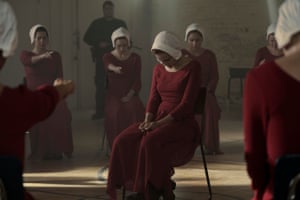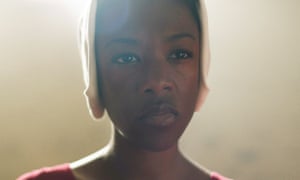'Horror in its purest sense': is The Handmaid's Tale the most terrifying TV ever? | Television & radio
It has been analysed as a dystopia, sci-fi, a political allegory, a cautionary tale and a feminist text, but The Handmaid’s Tale tends to get overlooked as horror, despite being the most terrifying show any of us have seen in years. This is horror in the purest sense of the word â€" psychological and bodily, full of a tension so sustained that you need a quiet sit-down afterwards to recover. It is relentlessly awful.
Right from the start it’s clear that this show is not messing around. Poor “batshit Janine†talks back at the Red Centre and is promptly dragged off, only to return with stained gauze over the hole where her eye once was. We see handmaids with missing hands and scarred faces being shunned in public and fetishised in private. We share Ofglen’s terror when she wakes to a bandaged crotch and a promise that her “deviant†sexual urges won’t bother her again. Any injuries our heroine Offred/June suffers â€" such as the whipping on the soles of her feet after her escape attempt â€" are shown in harrowing, closeup detail.

Such ubiquitous body horror is perhaps unavoidable in a show about a fictional republic where the women are reduced to no more than their bodies â€" and, in truth, just one particular function. So long as they can still conceive a child, it is irrelevant whether the rest of them is working. The Handmaid’s Tale is all about losing control of your own body, and the lengths you’ll go to to reclaim it. The sex scenes, by contrast, are free and sensuous, rare examples of June actually engaging with and enjoying her own body.
When I say “sex scenesâ€, I mean the consensual sex between June and her husband, Luke, and between June and Nick. For rape is the show’s other main source of terror. It is not dwelt on and shot like a sexualised torture scene. Rather, it is depicted quietly and sensitively, with the focus not on the act itself so much as the women’s reactions to it. The clinical, awful Ceremony scenes home in on details like the chandelier above June’s head as she struggles to take herself out of the moment. The camera closes in on her face and rather than watching it as an observer, we experience it alongside her. On the one occasion a handmaid is seen fighting back during the Ceremony â€" when Janine can’t take any more â€" it is no more shocking than the scenes where June suffers through it in silence, to protect herself.
The same is true of all the show’s horrors. The viewer is not allowed to be an impartial observer â€" we are in June’s head throughout. Each episode resonates, as we watch in fear of what might unfold next. Will traumatised women be forced to take their anger out by stoning another (probably) innocent prisoner? What sickening fantasies might the Commander conjure up for his “affair†with Offred? (The moment where June â€" and we â€" thought he wanted to have a threesome with her and Moira were some of the most frightening seconds ever committed to screen.) Will the evermore unstable Serena Joy plunge June into another domestic terror?

Most horror relies on outlandish setups. You enjoy being scared, because you are safely at a remove from the fear the story turns on. You’re unlikely to encounter zombies or ghosts or cannibals in real life, so you can watch it, jump out of your skin then go to bed feeling a mere tingle of nerves.
And of course, the world of Gilead is once removed from our own. It is a near-future dystopia and it falls into the sci-fi genre â€" or the speculative fiction genre, if you’re being fancy about it. But it is no less a world that feels horribly close, too close even, to ours. In fact, everything that happens â€" bar the handmaids and their despicable Ceremony â€" is happening somewhere in the world right now. Bursts of well-known songs constantly shock us into remembering that this could be our world if we veer just slightly more in the wrong direction. The victim-blaming and casual misogyny are uncomfortably recognisable. Trainee handmaids being forced to blame Janine for the rape she suffered is not all that different to the media and judges defending young men who “made a mistake†when they raped someone. And the Commander’s attitude to women â€" infantilising and fetishising them at the same time â€" is not dissimilar to that of a certain ridiculously-haired wo rld leader. Real-life terrors that we are able to feel distanced from because they’re “not happening hereâ€, such as FGM, being forced to flee your own country, and being denied basic rights, are westernised in The Handmaid’s Tale, so we face them head on.
Quite where The Handmaid’s Tale can go next remains to be seen. It’s already been commissioned for season two and Margaret Atwood’s world is rich enough that you could dig around in it for years and constantly find fresh material. Imagine what the unseen “colonies†could inflict upon the psyches of viewers. And what does an interrogation by the Eyes actually look like? Season two could also explore the indoctrination Gilead subjects its children to, or delve deeper into the regime’s relationship with religion. The Handmaid’s Tale is at its most frightening when it is close to home, so wherever it does head next, let’s hope it’s not too far removed from our own world.

0 Response to "'Horror in its purest sense': is The Handmaid's Tale the most terrifying TV ever? | Television & radio"
Posting Komentar